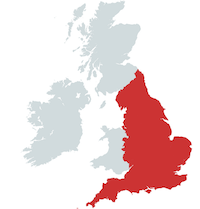
Map by mapchart.net - Some rights reserved.
Location
near Chillingham, Northumberland, England
Description
Chillingham Castle is located in the village of Chillingham in Northumberland, near the border between England and Scotland. The castle is built in a quadrangle with a large inner courtyard. There are numerous parts of the castle open to visitors.
The Armoury at the entrance has many weapons and memorabilia. The Great Hall was built for the Royal visit of James VI of Scotland. The walls display weapons and trophies from around the world. The Edward 1st Room is where Edward stayed on his journey to capture William Wallace. The Plaque Room has a fine plasterwork armorial plaque, and a display of paintings and photographs. The Museum has many artifacts of historical significance. The Great Hall and New Dining Room can be visited. There is a Minstrel's Hall with Minstrel's Gallery. The Berthele Room is full of prehistoric stones and weapons. The Torture Chamber has executioners blocks, an Iron Maiden with interior spikes, a scold's bridle, and thumb screws. The thick walls had passages running through them linking the castle towers. Some of these passages are now filled in. There is a dungeon with a heavy oak door with handles on only one side, and inside the dungeon is a drop to deeper chambers below. From the medieval courtyard you get a good view of the walls and towers.
The Castle is now open to the public and is available for weddings and private functions and has accommodation for about fifty guests. The adjacent park is under a separate ownership from the castle and is home to the Chillingham Wild Cattle.
History
Chillingham Castle was originally a monastery in the late 12th century. It was taken over by the Grey family in 1246 and was the seat of the Greys and their descendants the Earls of Tankerville from the 13th century until the 1980s. It was converted to a fortified castle in the mid 14th century. The castle occupied a strategically important location on the border between Scotland and England. It was used as a base for English armies entering Scotland, and was attacked and besieged several times by Scottish armies. King Edward I stayed at the castle in 1298 on his way to Scotland to battle a Scottish army led by William Wallace.
After the Union of the Crowns of Scotland and England, the need for a military stronghold declined, and the castle was gradually transformed to a stately home. The moat was filled, and the battlements were converted into residential wings. A banquet hall and library were added; the central stairway was added from the courtyard to the upper level of the castle, and the east range was remodeled. The grounds were extensively landscaped in the 18th and 19th century.
During World War II, the castle was used as an army barracks. After the war, the castle began to fall into disrepair. In the 1980s, the castle was purchased by Sir Humphry Wakefield, 2nd Baronet, whose wife Catherine is descended from the Greys of Chillingham. He restored the castle, and it is now a restoration of the castle, and it is now a hotel.
The Arts
Chillingham Castle was used for many historic scenes in the film "Elizabeth" ; "The Making of Harry Potter" was based at Chillingham; The Hollywood ghost film, "Most Frightened", was filmed at Chillingham
Chillingham Castle featured in an episode of "Ghost Hunters International", 2008; also in several episodes of the series "Scariest Places on Earth", 2000.
Legends
Chillingham Castle is said to be Ione of the most haunted castle in Britain. The most famous ghost of the castle is the "blue boy", who is supposed to haunt the Pink Room in the castle. Guests apparently reported seeing blue flashes and a blue "halo" of light above their beds.
Other Castles in the Area
Alnwick Castle, Northumberland
Bamburgh Castle, Northumberland
Dunstanburgh Castle, Northumberland
Edlingham Castle, Northumberland
Etal Castle, Northumberland
Lindisfarne Castle, Northumberland
Norham Castle, Northumberland
Warkworth Castle, Northumberland
|
|
|
|

